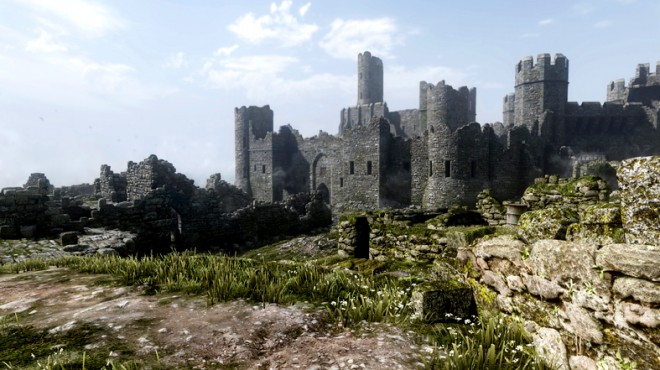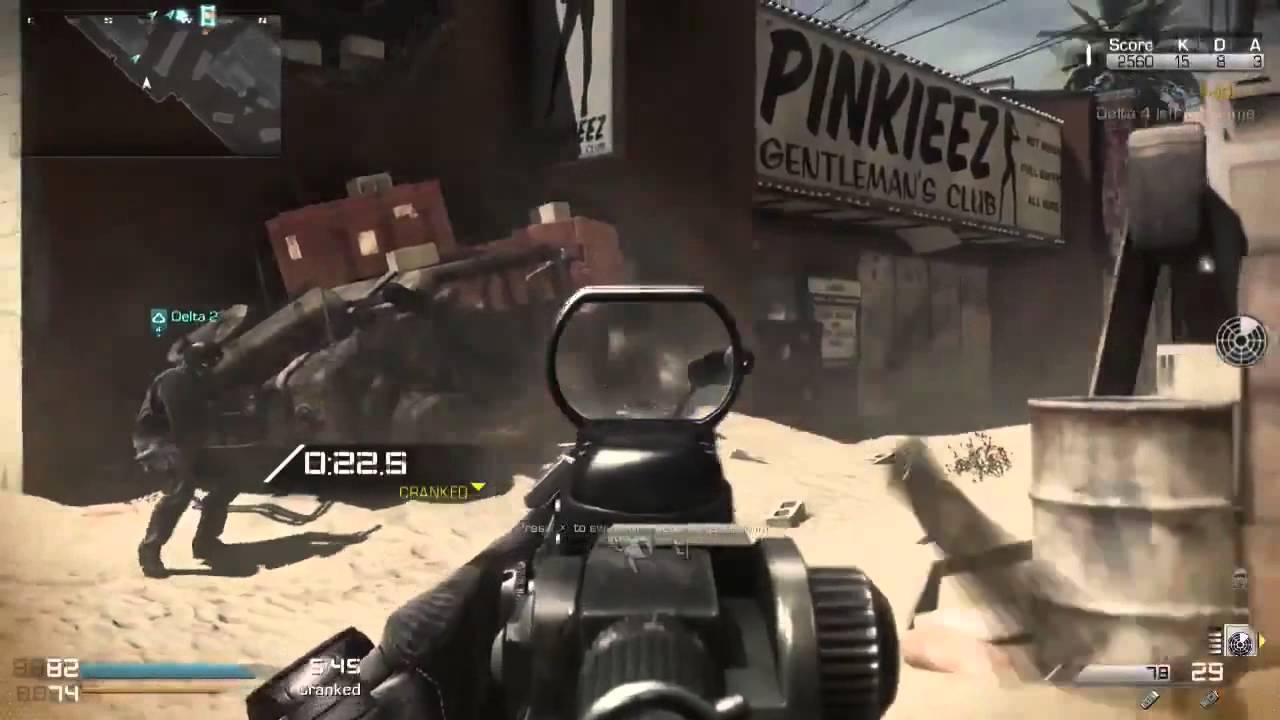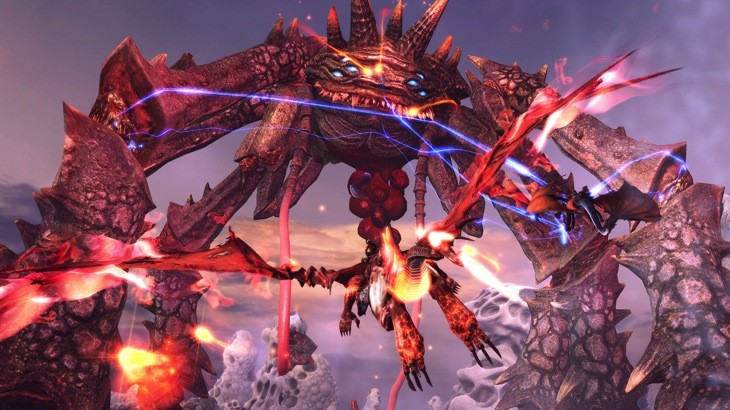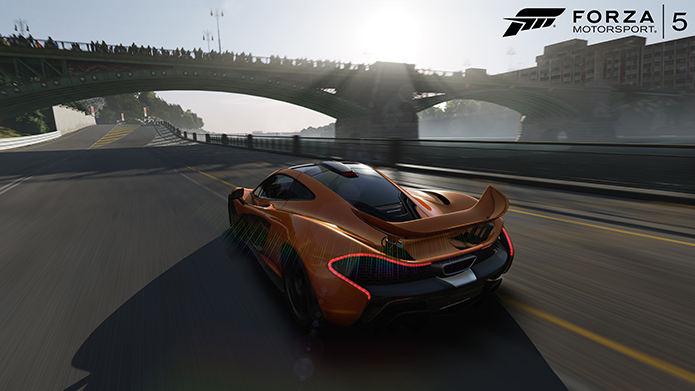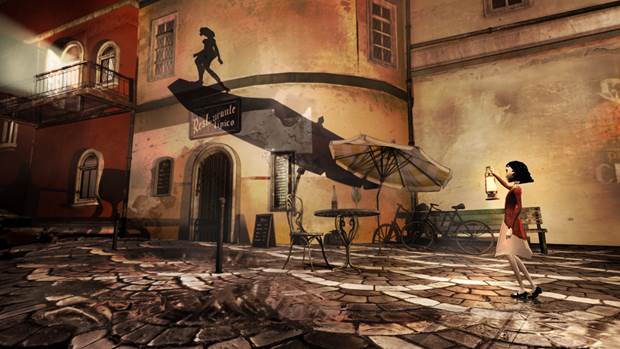Reviewed by: Jamaal Ryan
What looks to further resemble Battlefield's single/multiplayer divisiveness from Battlefield 3 to Battlefield 4, Call of Duty: Ghosts delivers more of an uneven experience. Ghosts' campaign is feeble. It's easily the most forgettable of the franchise with a painfully weak story, abandoned assets, and blatant redundancies among interesting yet overshadowed sequences. But while the franchise's tried and true multiplayer is Ghosts’ strong suit which offers the reasons why millions of players compete every year, it leaves a much less impressionable footprint than past entries.
Rinse, wash, repeat
Call of Duty Ghosts’ campaign is a refresher from Infinity Ward’s handlebar mustache toting Modern Warfare series. In place of chest thumping and occasionally suave British accented military comradery comes more chest thumping military comradery, but this time the relationship is blood deep. You play as the ineffectively mute protagonist Logan Walker, who along with his brother “Hesh” Walker, has joined what’s left of the American armed forces under command of their father in efforts to resist a devastating South American military threat.
It’s a story about two brothers fighting on American soil (and for some reason, across the globe of course) in an embroiled conflict to reclaim an already ravaged country, one that’s written by the Oscar award winning writer behind the highly regarded films Syriana and Traffic.
However the Hollywood talent behind Ghosts’ story is never apparent, ever. The posturing "We're Ghosts!" showboating, and graveled “’I’m proud of you son” one-liners is hardly good writing at all. Ghosts’ story, once again, moves forward in loading screens, but this time with dark, smokey, crystalized visual metaphors. It spends so much time utilizing loose rationale for location and sequence hopping across the globe and hardly ever enough time focusing on the brothers' story, that when it’s time for its predictable emotional climax, even more so than Call of Duty titles before it, there’s little reason to care.
Sooo... who are you guys again?
The campaign creates a number of new ideas bathed in numerous pace changing sequences that tries to keep things fresh. One minute I’m sneaking through a heavily patrolled forest Far Cry 3 style, the next I’m dipping under chest high water for cover as I move up on blasting enemy forces undetected.
One moment, I’m controlling a canine via remote sensors mauling unsuspecting enemies (which only lasts one chapter in the game), the next I’m barreling through a desert in a high speed tank blowing up enemy bases in a bright vastly open plane.
Some sections have me floating through space station debris engaging in muffled space shootouts; others will have me taking cover behind sunken ship remains from concussive sonar blasts deep underwater or– if I so choose – fend off sharks before they violently devour me.
You get the idea.
But with every fresh idea comes recycled ones as nearly all of Ghosts' levels conclude with an expected payoff which are different variations of "holy s**t" mad-dashes from angry pursuers as the world falls apart around you. It’s a bullet point adherence that fulfills criticisms of the franchise’s single player campaigns being little more than a series of explosions. This insidious volley of every fresh idea countered by recycled sequences creates a cantankerous experience, especially as it's layered under a deceptively shallow story.
New Motivation
Jumping into Ghosts’ multiplayer may expose players to a bit of a culture shock. But the biggest revelation is this: for over half a decade, Team Deathmatch was more than enough to keep Call of Duty players exclusively invested; however Ghosts seems to find most of its strength more on tactical gameplay.
This primarly has to do with the multiplayer map design which favors noticeably bigger, more obtuse levels – where somehow spawn kills have become more infuriatingly frequent – with many of them lacking obvious points of contact. While more explicit vocal locators are mildly effective inclusions, not much of Ghosts’ design makes finding enemy players easy, which is exacerbated by the unnecessarily complicated new SAT-COM killstreak which, in place of a straight forward single use radar, is now a two SAT-COM minimum placement requirement just to begin spotting enemies via radar sweeps.
On one end, Freight – a tighter industrial train depot – is the most classic style Call of Duty map in Ghosts with a centralized area where competing teams meet; but it doesn’t mean it’s as great as Call of Duty’s true classics. On the other you have Stonehaven, a massive Scottish themed location littered with stone built remnants where snipers and long ranged riflemen reign supreme. Some oddities fit in between such as Sovereign, which feels like a disorganized set of rooms and walkways on two floors, and Flooded: a slightly better designed three story dam split in half that draws attention to locations on either side. Whereas many of these maps excel in one particular play style – Octane is a s**tty TDM map, but a spectacular Cranked map – they are not properly optimized for others.
Keep your head way the f**k down.
These newly designed maps do however do a decent job in supporting the new maneuverability mechanics. Slightly raised obstructions invite you to vault over them and keep your momentum going, and vertical accesses are less of a hassle to get to. Ghosts’ overall level design is also peppered with plenty of corners to peek around, which is where the knee slide and contextual lean find their purpose. And though you may not find yourself using these mechanics as much in Team Deathmatch (outside of the vault of course), they have better placement in more objective based match types.
Being that game types with a greater purpose than kill-kill-kill make better use of Ghosts’ new maps, your time will often be better spent in some of multiplayer’s new modes. Chief among the new objective based additions are Blitz: a one way Capture-the-Flag style game, and Search and Rescue: a fusion of Search and Destroy and Kill Confirmed.
Blitz alleviates the headache of being a flag carrier by only requiring players to run into an enemy's defended zone to score points. This simple omission of escorting flags drastically changes the behavior in this new variation. Skilled and even coordinated players will grief the opposing team by holding them off from defending their own zone before entering it one by one during 10 second countdown timers between each score. It's a straight forward if not streamlined way to play, and you won't ever miss playing another round of capture the flag in Call of Duty.
Search and Rescue is one of the most methodically encouraging game modes in Call of Duty’s history. The objective of destroying the enemy’s high value targets while risking being killed out of the round permanently remains the same. However Search and Rescue borrows Kill Confirmed’s dog tags where if an enemy picks up your dog tag, you’re out for the round; if an ally recovers your tag, you’ll get a second wind. Search and Rescue strongly encourages teamwork not only to defend bomb sites, but to keep your buddies alive.
But in efforts to not only keep the kill stacking driven attitude of Call of Duty, instead to enhance it, Call of Duty Ghosts brings us Cranked, a highly skill based match type much like what SWAT is to Halo.
In this very aggressive new game mode, initial or after death kills rewards players with a dramatic speed boost. Perks like Stalker, Lightweight, Marathon, and Slight of Hand are all activated and super charged. The catch is that you have to earn a kill within 30 seconds to reset your time or else you'll explode.
Though Cranked is a TDM variant, Cranked pressures players to take risks that wouldn't be justified in any other mode, forcing everyone out in the open frantically hunting down other players to reset their clock. It feels like playing on Nuketown on every map it takes place in, except with an added layer of gratification earning a kill just milliseconds away from detonation, and the hilarity of watching those not as fortunate.
No performance enhancement drugs necessary.
However if Cranked’s intensity is too overbearing, Kill Confirmed is still a great alternative, eliciting much of the same risky behavior that alleviates much of the downtime and diminished focus these new maps bring.
Blitz, Search and Rescue, and Cranked are all welcomed additions to the Call of Duty franchise. But there’s a lack of experimental game types that have given options for Call of Duty players to toy around with. Party Games are noticeably missing, and some of the other additions such as Hardpoint and Multi-Team Deathmatch – both in which would have been perfect for Ghosts’ new expanded level design – are also out of the picture. This continues the franchises strange back and forth between the two developers, injecting new ideas while taking others away.
Ghost in the Machine
I gave considerable credit to Combat Training’s learning curve for newcomers in Black Ops 2. Squads Mode carries the same intention as did Combat Training, however it’s much less academic than Treyarch’s offering.
Squads feels more appropriate for those that graduated from Black Ops 2's Combat Training than for those who are new to the franchise in general. The AI controlled players are properly cheap, knowing where to aim at the precise time -- even if your loadout is strictly optimized for stealth -- and are more challenging in general. They're either far too challenging for new players (outside of Recruit difficulty on Wargame) or far too simple on one end and behaviorally unfair on the other for players who are looking for a more organic experience.
All the modes are different variations of bot challenges. Wargame is the most new-player friendly where you’re simply facing off against randomized bots on selected difficulties, whereas Squad Assault has you challenging bots that are hand selected by other players asynchronously. Squad v Squad is the most interesting iteration of the bunch where it has two players and their chosen squad members battle each other.
Outside of being an overzealous training grounds, playing Squads does contribute earned EXP to your standard multiplayer progress, and the sheer number of squad member loadout slots open opportunities for players to experiment with Call of Duty: Ghosts’ massive number of customization options.
The odd man out in Squads is Safeguard, which was assumed to be the return of Survival from Modern Warfare 3; however it's considerably less interesting than its predecessor albeit it being mindless fun. Safeguard strips much of Survival's core assets which you'll only find in Extinction: earning cash for new weapons, equipment, and support, and granted down time to properly prepare for the next wave.
What's left is a barebones, straight forward standoff against waves of enemies with frequent supply drops that gift perks, weapons and auto supports. Progression only lies in nebulous leveling weapon proficiencies, however weapons aren't customizable. And the longer you last gives you more opportunity to stack perks which makes guilty fun when running circles around the AI controlled competition. All in all however, Safeguard isn't nearly as compelling as MW3's Survival Mode, and it can't be helped but to think that it was intentionally designed this way just to siphon attention to Extinction.
Your move Zombies.
Extinction is what Dead Ops Arcade was to the original Black Ops. It's a surprising addition to Ghosts in the same vain as Treyarch's Zombies and offers a different co-op experience to Survival Mode. Unlike Zombies, Extinction's objectives are more direct and simple enough for even a team that isn't communicating can understand. Four players must carry and escort a drill around a ruined city and defend it against agile aliens as it destroys each hive -- marked on the HUD -- until you reach the crater. Gunning down aliens gives a vastly different flavor than what's expected in Call of Duty games. The leaping predators demand you to keep your attention above as well as on the ground, making the game much more akin to Left 4 Dead than anything else.
There's only one chapter available for Extinction currently, and though more chapters are bound to arrive via DLC, Point of Contact can hold its own replayability for the time being. The unlocks are separate from Ghosts' multiplayer proper, much like how Survival was in MW3, and Extinction doesn't completely abandon Zombies' idea of discovery with hidden secrets tucked away throughout the city. Extinction is a more than welcomed addition to Call of Duty, and is easily one of the very best co-op experiences in the franchise.
A Flavorless Investment
What players might grow to learn is that Ghosts' competitive multiplayer also feels as if it's artificially engineered to produce longevity. With 35 perks, 12 different pieces of equipment, 24 killstreaks, and 30 firearms each with their own number of attachments – some of which have their own manufactured attachments integrated, there is a significant amount of unlocks to choose, purchase, and assort in Ghosts’ version of the Pick 10 system. But this is where the ingeniousness comes in, the market place.
The original Black Ops introduced a currency system in place of just earning rewards via leveling up. Black Ops 2 streamlined this system by having fewer perks, making it easier for players to make decisions. However Ghosts carries ever Treyarch's monetary system paired with a daunting level of unlocks that gives the impression that you're in for the long haul, especially when perks like Marathon, Overkill, and Stalker are made available in the much higher levels at a cost.
But what's most offensive is the squads themselves. Though it makes sense to charge per new squad member (up to 5 extra members only cost 3 SP a pop, the last 4 charge 200 and up), it makes for an even longer investment when you have to repurchase all the weapons, perks and killstreaks for each new member. It doesn’t feel honest, and makes playing Ghosts a hassle just to access everything that's available, especially given that Ghosts doesn’t have the robust feature suite the Black Ops series has built to keep players properly distracted.
Hire a new squad member, and you gotta buy ALL this s**t again.
This is Call of Duty Ghosts’ biggest flaw. Say what you will about the Call of Duty franchise, but each new installment has brought something of significance to the brand. Modern Warfare reinvented the franchise and shooters this generation, World at War made World War 2 relevant and introduced Zombies, Modern Warfare 2 evolved and expanded the killstreak system, Black Ops began taking the franchise in an all new direction, Modern Warfare 3 brought us Strike Packages, and Black Ops 2 began the Pick 10 system.
Call of Duty Ghosts doesn’t have its own feature to live by, let alone an extensive feature set as we’ve seen in past entries. Extinction could have been that new addiction if it simply wasn’t for the already established Zombies Mode. Squads is nothing more than an elaborate training ground for less experience players, and the new modes don’t make up for what’s gone missing. Ghosts presents a significant amount of unlocks to earn and choose from, however the journey getting there will likely get tedious far too quickly.
The Bottom Line
Call of Duty: Ghosts is the weakest jump in the series, which makes you wonder if this is a product of being a three studio project. The campaign is almost a miserable waste of time, often a frustrating tease of inventive ideas at best. This may not mean much to immediate multiplayer divers, however those who have enjoyed Call of Duty’s past stories in all their flawed glory will find little to appreciate here.
Multiplayer, both competitively and cooperatively, is a divisive surprise as a whole. Despite new instant classic modes, Ghosts’ competitive space doesn’t have a whole lot to say so much so as giving players a lot to work for. Extinction however is this entries strongest contribution, delivering the franchise’s most entertaining cooperative experience to date while still retaining incentivized replayability.
But in light of Ghosts’ let downs, it’s a profound example showing that the COD formula still works, making a still good shooter seven annual installments in.
+ New classic multiplyer modes
+ Plenty of opportunities for custom loadouts
+ Extinction Mode
- Cannot recommend the campaign
- Unnecessarily complex map design
- Loss of quantitative variety in game modes hurts
SCORE: C+


